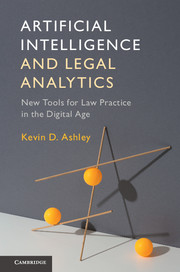Book contents
- Frontmatter
- Dedication
- Contents
- List of illustrations
- List of tables
- Acknowledgments
- PART I COMPUTATIONAL MODELS OF LEGAL REASONING
- PART II LEGAL TEXT ANALYTICS
- 6 Representing Legal Concepts in Ontologies and Type Systems
- 7 Making Legal Information Retrieval Smarter
- 8 Machine Learning with Legal Texts
- 9 Extracting Information from Statutory and Regulatory Texts
- 10 Extracting Argument-Related Information from Legal Case Texts
- PART III CONNECTING COMPUTATIONAL REASONING MODELS AND LEGAL TEXTS
- Glossary
- Bibliography
- Index
9 - Extracting Information from Statutory and Regulatory Texts
from PART II - LEGAL TEXT ANALYTICS
Published online by Cambridge University Press: 13 July 2017
- Frontmatter
- Dedication
- Contents
- List of illustrations
- List of tables
- Acknowledgments
- PART I COMPUTATIONAL MODELS OF LEGAL REASONING
- PART II LEGAL TEXT ANALYTICS
- 6 Representing Legal Concepts in Ontologies and Type Systems
- 7 Making Legal Information Retrieval Smarter
- 8 Machine Learning with Legal Texts
- 9 Extracting Information from Statutory and Regulatory Texts
- 10 Extracting Argument-Related Information from Legal Case Texts
- PART III CONNECTING COMPUTATIONAL REASONING MODELS AND LEGAL TEXTS
- Glossary
- Bibliography
- Index
Summary
INTRODUCTION
Attorneys, citizens, business personnel, and policy-makers all need to access and understand regulatory texts in order to discover what the legal rules are and how to avoid violating their requirements. Thus, AI & Law has long aimed at automatically extracting information about the rules’ requirements from electronically stored statutory and regulatory texts.
This chapter presents some ML and KE techniques for extracting information from statutory texts, including regulatory topics and concepts, types of norms or rules, and some functional elements of statutory provisions. We examine the relative merits of using ML and rule-based approaches to automatically classify statutory provisions and extract functional information from them.
The chapter then focuses on the more ambitious goal of extracting logical rules from statutes and regulations. Ideally, one could extract business rules from statutes automatically. The extracted rules could be applied deductively as in Section 2.3.4 or as defeasible rules in process compliance as in Section 2.5.3. Engineering design environments might, for example, help ensure that systems are designed to be compliant with rules extracted from regulations that have been formalized and integrated into the design process. That would extend even farther an approach to compliant design like the one in Section 2.5.5. Alternatively, defeasible rules, extracted from statutory texts, might be used in legal arguments as in Section 5.3.1. A QA system might use the extracted rules to answer questions about their requirements in legally sophisticated ways as suggested in Section 5.9. Unfortunately, however, the results of efforts to extract rules from regulatory texts fall far short of the ideal for automating reasoning in these ways.
Even without automating reasoning with extracted statutory rules, however, techniques for extracting information automatically from statutory texts can support cognitive computing in a variety of other ways. Automatic extraction facilitates conceptual information retrieval from corpora of statutory texts. Annotating provisions automatically in terms of semantic concepts drawn from a legal ontology such as the e-Court or Dalos ontologies of Sections 6.3.1 and 6.4 enables users to retrieve documents based on their conceptual content. A program could also automatically generate abstracts or summaries of statutory provisions in terms of the relevant concepts.
- Type
- Chapter
- Information
- Artificial Intelligence and Legal AnalyticsNew Tools for Law Practice in the Digital Age, pp. 259 - 284Publisher: Cambridge University PressPrint publication year: 2017

